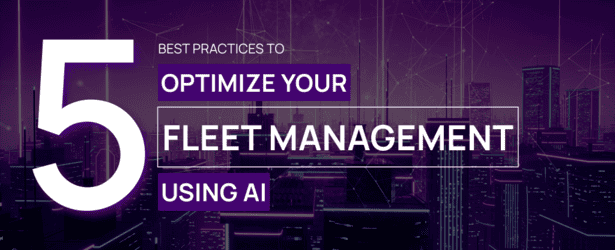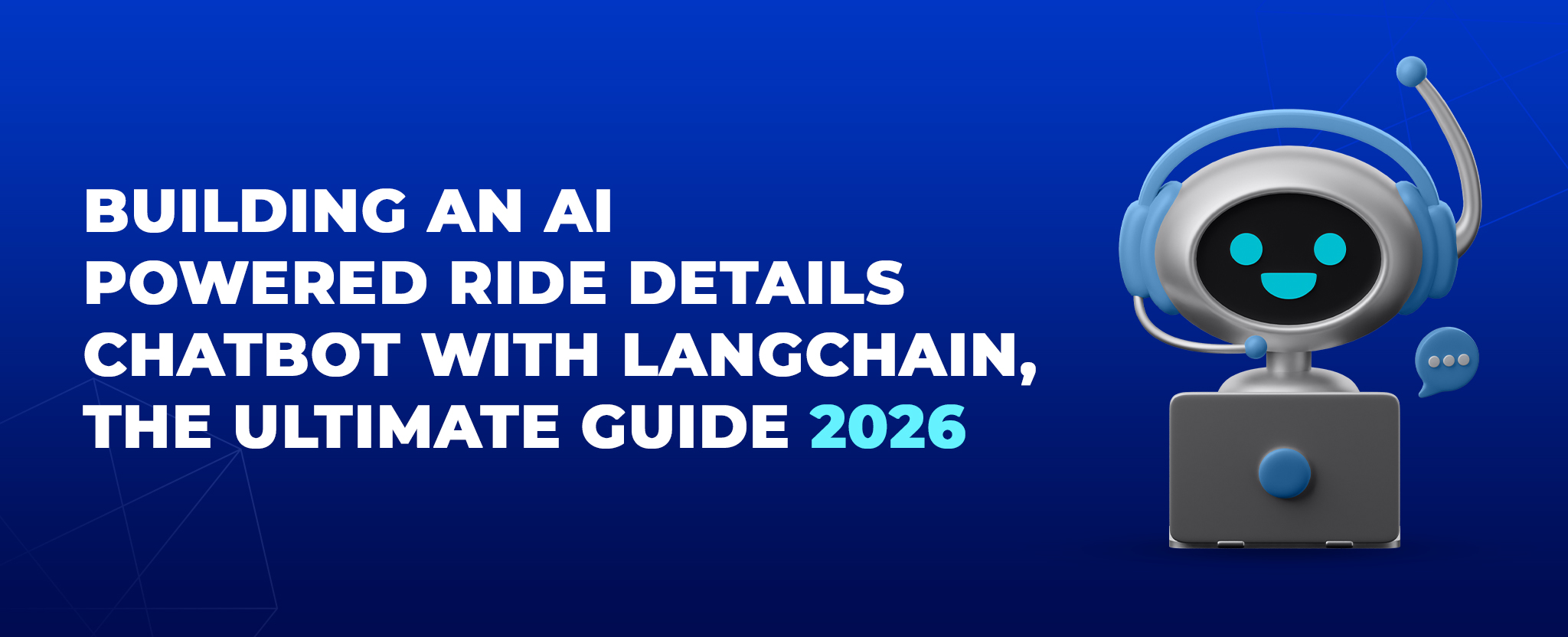5 Best Practices to Optimize your Fleet Management Using AI
8 Jul 24 


The world of fleet management is changing, and artificial intelligence (AI) is leading the way. By utilizing AI-powered technology, businesses can optimize operations, streamline processes, and make informed decisions. This innovative approach enables fleet managers to overcome traditional challenges, increase productivity, and gain valuable insights into their operations.
In this blog, we’ll explore the incredible ways AI is transforming fleet management. We’ll talk about the benefits, key features, and the development process.
The Role of AI in Fleet Management

The wonders of AI-powered fleet management apps! These cutting-edge tools are revolutionizing the way fleets operate, making them more efficient, productive, and cost-effective. Let’s break down the key features and benefits of these incredible apps.
Predictive Maintenance
Imagine having a crystal ball that predicts when your vehicles need maintenance, allowing you to schedule repairs before breakdowns occur. That’s exactly what AI-powered fleet management apps offer. By analysing vehicle usage, performance data, and historical patterns, these apps can identify potential issues before they become major problems. This means less downtime, reduced repair costs, and extended lifespans for your fleet assets. It’s like having a team of expert mechanics working around the clock to keep your vehicles running smoothly.
Route Optimization
Who doesn’t love saving time and reducing fuel consumption? AI algorithms analyze real-time traffic data, weather conditions, and historical travel patterns to optimize routes for maximum efficiency. They consider delivery schedules, vehicle capabilities, and other factors to ensure that your drivers are always taking the most direct routes. The result? Reduced travel time, lower fuel bills, and happier customers.
Driver Behaviour Analysis
Safety is paramount in fleet management, and AI-powered apps have got you covered. By analysing driver behaviour, these apps can identify patterns related to harsh braking, acceleration, and speeding. This valuable insight allows fleet managers to address safety concerns, improve fuel efficiency, and reduce the risk of accidents. It’s like having a personal coach riding shotgun with each driver, providing feedback and guidance to help them improve their skills.
Real-Time Decision Support
Fleet managers imagine having access to real-time data analysis and decision support at your fingertips. AI-powered apps provide just that, enabling you to make informed decisions on the fly. Need to reroute a vehicle due to unexpected traffic congestion? No problem. Want to adjust delivery schedules based on changing weather conditions? With AI-powered apps, you’re always one step ahead of the game.
Also Read: Why Should You Use a Truck Booking App?
Developing AI-Powered Fleet Management Apps

Data Integration
Developers must integrate AI algorithms with real-time data streams from various sources, including vehicles, IoT devices, and external providers. This includes GPS data, telematics, weather information, and traffic updates to enable AI-driven decision-making. The integration process involves connecting to multiple APIs, handling large volumes of data, and ensuring data quality and integrity. Additionally, developers must implement data encryption and security measures to protect sensitive information. A robust data integration framework is crucial for building an effective AI-powered fleet management app.
AI Model Training
Training AI models to analyze vehicle performance, driver behavior, and route optimization requires extensive data collection, preprocessing, and model training. Developers must gather vast amounts of data from various sources, clean and preprocess the data, and then train the AI models using machine learning algorithms. The goal is to develop accurate, reliable, and adaptable AI models that can learn from new data and improve over time. To achieve this, developers must iterate through multiple training cycles, fine-tune model parameters, and validate model performance using metrics such as accuracy, precision, and recall.
User Experience Design
UI/UX design for AI-powered fleet management apps should prioritize intuitive interfaces, real-time data visualization, and adaptive decision support. Users expect a seamless and engaging experience, so designers must focus on creating visually appealing dashboards, clear navigation, and easy-to-use features. Moreover, the app should provide personalized experiences tailored to individual users’ needs and preferences. User feedback and iterative design are essential for creating a user-centric app that meets the evolving needs of fleet managers and drivers.
Deployment and Iterative Improvement
Deploying AI-powered fleet management apps involves rigorous testing, user feedback, and continuous improvement cycles. Before deployment, developers must conduct thorough testing to ensure the app meets functional and performance requirements. After deployment, they must collect user feedback, monitor app performance, and identify areas for improvement. Iterative updates based on real-world usage data ensure that the app remains effective and responsive to evolving business needs. This ongoing cycle of improvement helps maintain user satisfaction, fix bugs, and add new features to stay competitive.
Benefits of AI-Powered Fleet Management Apps

Proactive Maintenance
AI-powered predictive analytics minimize downtime and reduce repair costs by identifying maintenance needs before they lead to breakdowns or failures. By analyzing real-time sensor data, AI algorithms can detect anomalies, predict component failures, and alert fleet managers to schedule proactive maintenance. This proactive approach saves time, reduces costs, and ensures that vehicles are always available for operation.
With AI-powered predictive analytics, fleet managers can identify potential issues before they cause problems. For example, if an engine sensor detects unusual vibrations, the AI algorithm can analyze the data and predict a possible failure. The system can then alert the fleet manager to schedule maintenance, preventing a costly breakdown. This proactive approach not only saves money but also reduces downtime, ensuring that vehicles are always available for operation.
Moreover, AI-powered predictive analytics can help extend the lifespan of vehicles and equipment. By detecting wear and tear patterns, the system can recommend maintenance schedules that prevent premature wear. This leads to significant cost savings over the long term, as well as improved overall efficiency.
Fuel Efficiency
Dynamic route optimization based on AI algorithms minimizes fuel consumption, reduces travel time, and lowers operational costs. AI-powered route optimization considers factors such as traffic patterns, road conditions, and weather forecasts to optimize routes in real-time. By reducing fuel consumption, fleet operators can decrease their carbon footprint, lower operating expenses, and improve overall efficiency.
AI-powered route optimization is a game-changer for fleet operators. By analyzing real-time traffic data, the system can identify the most efficient routes, reducing fuel consumption and lowering emissions. This not only saves money on fuel costs but also helps reduce the environmental impact of fleet operations.
Furthermore, AI-powered route optimization can help improve customer satisfaction. By reducing travel time, fleet operators can deliver goods and services faster, leading to increased customer satisfaction and loyalty. Additionally, the system can provide real-time updates to customers, keeping them informed of delivery status and estimated arrival times.
Safety and Compliance
AI-powered driver behavior analysis enhances safety, reduces the risk of accidents, and ensures compliance with regulatory requirements. AI algorithms can analyze driver behavior, identify risky habits, and provide personalized coaching to improve driving skills. Additionally, AI-powered apps can monitor compliance with regulations, such as hours of service, and alert fleet managers to potential violations.
AI-powered driver behavior analysis is a powerful tool for improving safety on the roads. By analyzing driver behavior, the system can identify risky habits, such as speeding or aggressive braking. The system can then provide personalized coaching to drivers, helping them improve their skills and reduce the risk of accidents.
Moreover, AI-powered apps can help ensure compliance with regulatory requirements. By monitoring hours of service, the system can alert fleet managers to potential violations, reducing the risk of fines and penalties. This not only saves money but also helps ensure that drivers are well-rested and alert, reducing the risk of accidents.
Real-Time Decision Support
AI-driven decision support systems empower fleet managers to make informed, adaptive decisions in response to changing conditions, improving overall operational efficiency. By analyzing real-time data, AI algorithms can provide actionable insights, recommend optimal routes, and suggest proactive maintenance schedules. This real-time decision support enables fleet managers to respond quickly to disruptions, optimize resources, and maximize productivity.
AI-driven decision support systems are essential for fleet managers who need to make quick decisions in response to changing conditions. By analyzing real-time data, the system can provide actionable insights, helping fleet managers respond to disruptions, such as traffic congestion or inclement weather.
Moreover, AI-driven decision support systems can help optimize resource allocation. By analyzing real-time data, the system can recommend optimal routes, reducing fuel consumption and lowering operational costs. Additionally, the system can suggest proactive maintenance schedules, ensuring that vehicles are always available for operation.
Also Read: How To Build Truck Booking App For Shippers & Transporters
Best practices to optimize your fleet management using AI
Define Clear Goals and Objectives
Before implementing AI in your fleet management, define what you want to achieve. Do you want to reduce fuel consumption, improve safety, or increase efficiency? Having clear goals will help you determine the right AI solutions for your business.
Identify Key Performance Indicators (KPIs): Establish measurable KPIs to track the success of your AI implementation. Examples of KPIs include fuel consumption reduction, accident rate decrease, or increase in on-time deliveries.
Conduct a Needs Assessment: Analyze your current fleet management processes to identify areas where AI can bring the most value. This will help you prioritize your goals and objectives.
Involve Stakeholders: Engage with stakeholders across your organization to ensure everyone is aligned with the goals and objectives of your AI implementation.
Choose the Right Data
AI relies on high-quality data to make accurate predictions and decisions. Ensure that you collect relevant data from various sources, such as sensors, GPS, and maintenance records. Clean and preprocess the data to remove errors and inconsistencies.
Data Sources: Identify the most relevant data sources for your AI implementation, such as:
- Sensor data from vehicles and equipment
- GPS tracking data
- Maintenance records and history
- Driver behavior and performance data
- Weather and traffic data
Data Quality: Ensure that your data is accurate, complete, and consistent. Remove any duplicates, outliers, or irrelevant data points.
Data Preprocessing: Clean and preprocess your data to prepare it for AI analysis. This may involve normalizing, transforming, or aggregating data.
Select the Appropriate AI Algorithm
Different AI algorithms are suited for specific tasks. For example, machine learning algorithms are ideal for predictive maintenance, while deep learning algorithms are better suited for image recognition. Choose the right algorithm for your specific use case.
Machine Learning Algorithms: Suitable for predictive maintenance, demand forecasting, and route optimization.
Deep Learning Algorithms: Ideal for image recognition, object detection, and natural language processing.
Neural Networks: Useful for complex pattern recognition, classification, and regression tasks.
Integrate AI with Existing Systems
AI should complement your existing fleet management systems, not replace them. Integrate AI with your current software and hardware to ensure seamless data exchange and minimal disruption to your operations.
API Integration: Use application programming interfaces (APIs) to connect your AI system with existing systems, such as fleet management software, GPS tracking systems, and maintenance databases.
Data Exchange: Ensure seamless data exchange between your AI system and existing systems, using standardized formats and protocols.
System Compatibility: Verify that your AI system is compatible with your existing infrastructure, including hardware, software, and network architecture.
Monitor and Evaluate AI Performance
Regularly monitor and evaluate the performance of your AI system to ensure it’s meeting your goals and objectives. Identify areas for improvement and make adjustments as needed.
Performance Metrics: Track key performance metrics, such as accuracy, precision, recall, and F1 score, to measure the effectiveness of your AI system.
Error Detection: Implement error detection mechanisms to identify and correct mistakes made by your AI system.
Continuous Improvement: Regularly update and refine your AI system to adapt to changing business needs and improve performance.
Also Read: Logistic App Development: An Overview of Cost to Outsourcing Truck App Developers
Final Thoughts
Developing AI-powered fleet management apps is a strategic move that keeps your business competitive. With real-time data analysis and intelligent decision-making, you can stay one step ahead, anticipating needs and improving operations.
So, why settle for traditional methods when AI-powered mobile apps offer a world of opportunities? It’s time to tackle the transformative power of AI and take your fleet management game to the next level!
- Agentic AI1
- Android Development3
- Artificial Intelligence33
- Classified App3
- Custom App Development5
- Digital Transformation12
- Doctor Appointment Booking App14
- Dropshipping1
- Ecommerce Apps40
- Education Apps2
- Fintech-Apps37
- Fitness App4
- Flutter4
- Flutter Apps20
- Food Delivery App5
- Grocery App Development1
- Grocery Apps3
- Health Care10
- IoT2
- Loyalty Programs9
- Matrimony Apps1
- Microsoft1
- Mobile App Maintenance2
- Mobile Apps128
- Product Engineering6
- Progressive Web Apps1
- React Native Apps2
- Saas Application2
- Shopify9
- Software Development3
- Taxi Booking Apps7
- Truck Booking App5
- UI UX Design8
- Uncategorized6
- Web App Development1



















Comments